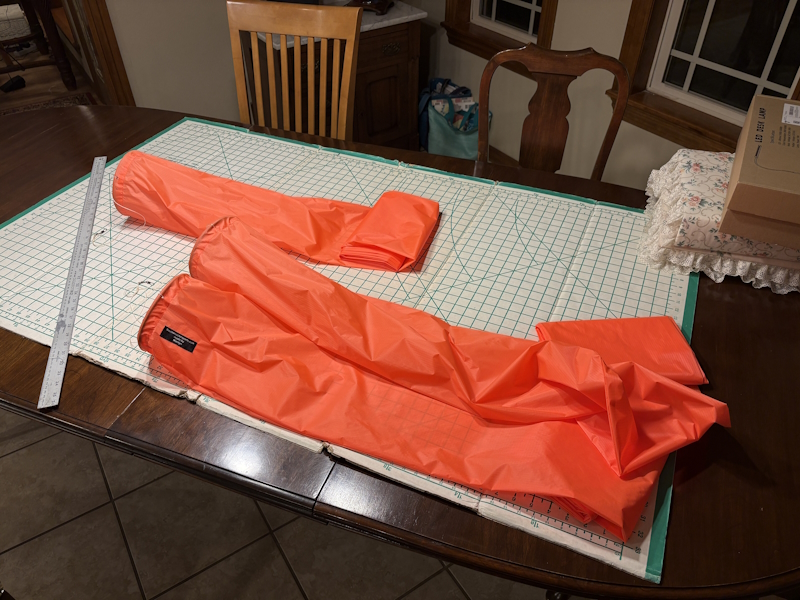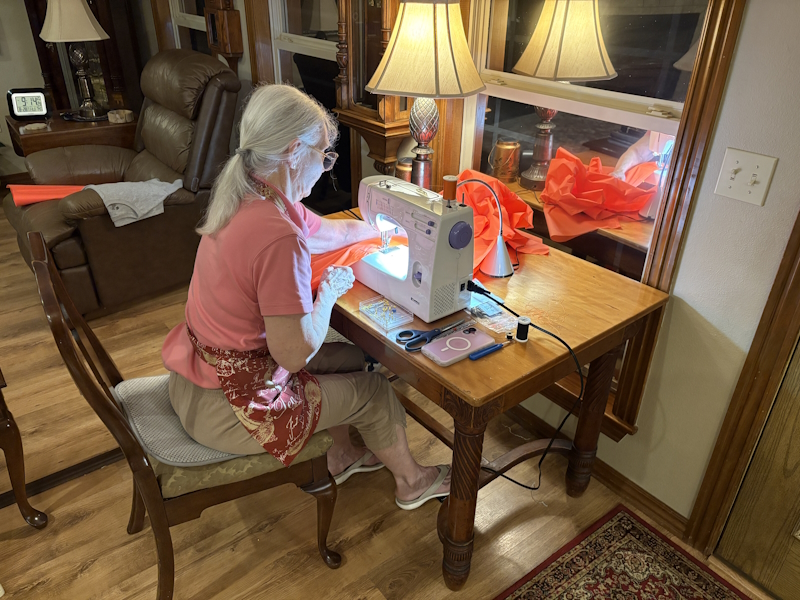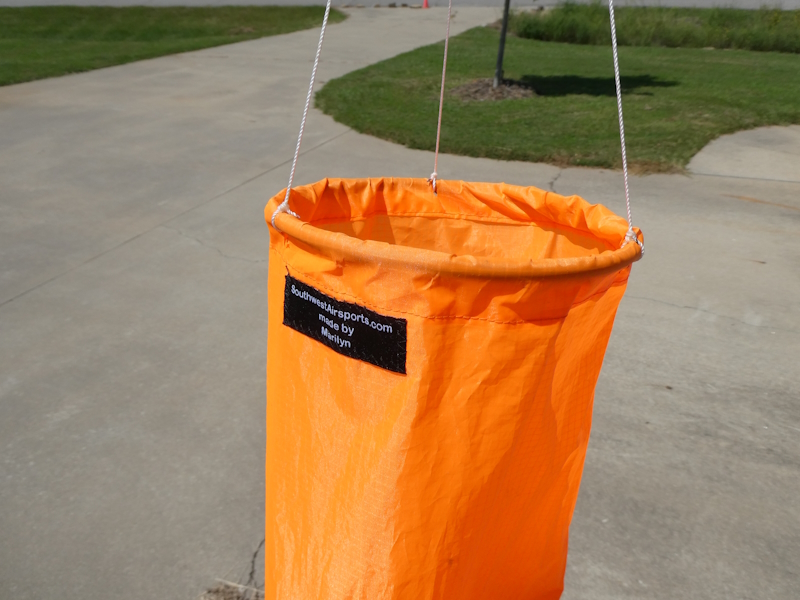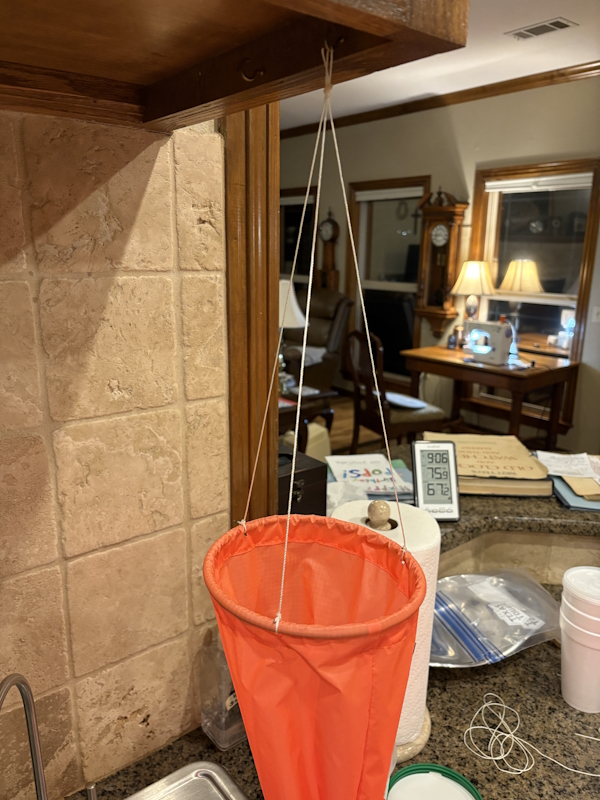Premium windsock for Paragliding, Hang Gliding, & Skydiving
made by Marilyn
Price includes FREE shipping to continental U.S. addresses
- $55 For shipping outside the continental US, place your order and we will contact you per additional shipping charges.
Please be patient! There can be 7-21 days before we can ship these windsocks out, especially during training season.
Be SURE to read the setup instructions below for important information for using the sock correctly. It is not so simple as many think....
Why this handcrafted windsock is superior to all others. Harmonized Tariff Schedule (HST) code for this item: 9503.00 (for international shipping)
Features
- 40D nylon ripstop fabric i.e., tent fabric. No other sock uses this quality of fabric.
- Sock opening is reinforced with a sewn-in piece of polyethylene tubing that keeps the round shape of the sock – a feature that is unique and not found in any other windsock of this type.
- Overall length approximately 15', just right for all flying conditions.
- Visibility of (1) mile or more – pilots and skydivers can safely setup for landing much further away than with ordinary windsocks.
- Ultra sensitive to wind speed and direction – when setup according to our instructions, it will start to move and indicate direction and speed with winds less than 1 MPH.
- Greatly assists landing setup at or near dusk or from high altitude when cheaper windsocks or streamers are hard or impossible to see.
- Typical life is 7 years depending on sun exposure, average wind velocity, and handling.
- This windsock can be safely struck by gliders and skydivers without injury if it is attached to a Crappie (Pan) pole. Please read the setup instructions below for more information on this. If struck, the windsock assembly simply falls down flat on the ground and out of the way. The design of this windsock system is much safer to hit than a windsock that is attached to a permanent structure.
- Hand crafted by Marilyn in the U.S.A. at our shop.
- Think about it: How much is your flying safety worth? That is why we designed this premium sock that has no equal.
NOTE: THE ORANGE COLOR OF THE SOCK MAY VARY SLIGHTLY FROM THE PHOTOS HERE, DEPENDING ON OUR FABRIC SUPPLIER.
Marilyn Robinson at work in her shop – working on a 1,000' streamer for an air show. She has assisted in the training of pilots for over 18 years and knows that setting up to land as far away as possible is vitally important to pilots and skydivers – and why she created this windsock.
Accessories needed for the windsock (do it yourself)
The Crappie (Pan) fishing pole must have the thinnest sections possible so that the sock will move in the slightest breeze but not touch the pole.
DO NOT USE A HEAVY DUTY CRAPPIE – IF YOU DO, YOUR SOCK WILL NOT FUNCTION CORRECTLY IN LIGHT AIR.
- Option #1 (best) 16' 6" Crappie fishing pole – available from Cabelas (page down to see the pole length option choices). Using this pole instead of the more expensive 20' (option #2 below) cuts down on replacement costs over the long haul. A longer pole should not be needed if a PVC pipe is used to extend the height. The advantage of a longer pole is that it takes up less space in your vehicle because only a short piece of PVC pipe is needed.
-
The pole needs a split piece of 1" tubing attached about 1' up from the base
with nylon zip ties to keep it from sliding down the PVC pipe (see this photo).
-
1 1/2" x 6' PVC schedule 40 pipe Longer pieces are always better but may not fit in a car or truck bed.
Remove the base cap at the bottom of the pole. Use duct tape to seal the base so you can
use this narrower sized PVC pipe. The base MUST be sealed to keep the pole sections from falling out.
-
3/4 x 30" steel concrete form stake
(best) 1/4" bolt
installed 12" from top of the stake can be used to increase the height of the longer PVC pipe OR use a 5/8 x 3' or longer piece of rebar. If you do use rebar, grind
the ridges off where it goes in the ground as these make the pole difficult to take in and out.
OR - Option #2 20' Crappie fishing pole – also available from Cabelas. Note: The longer poles are more expensive, wider at the base, easier to damage, and not needed if the 16' 6" pole and a 6' piece of PVC is used.
-
2" x 3' PVC – this diameter pipe will fit most 20' Crappie poles.
- 3/4" x 30"-36" steel concrete form stake (best) OR a 5/8" x 3' piece of rebar.
Our handcrafted socks ready to ship

Skydiving alterations to windsocks
Skydivers have asked for a sock with a white tail that will be easier to view straight overhead in the DZ by the less experienced. We just received white tent fabric and will soon offer a windsock option that has a 12" long white tail attached to the end of the sock. As some skydivers have noted, the white tail will help make wind direction in the DZ easier to determine from altitude. It is a safety issue.
Meanwhile, you may use white fabric spray paint (available from Hobby Lobby and others) to create an observable tail. Fabric paint is flexible.
Here is how to do it: Mask off the last 12" of the sock using masking tape. You will need some kind of internal support to keep the sock cylindrical while spraying it with paint. We recommend making a heavy paper/cardboard cylinder. Tape the end of the cylinder AFTER inserting it into the end of the sock. Do NOT soak the sock with paint! Put just enough on to give a good contrast. Let it dry thoroughly. If you do not follow these steps, the sock could become glued together at the end and/or take on a non-cylindrical shape.
Repairs
1. Tip repairs
The Crappie pole is delicate and is usually the first part to break from rough handling. If the end tip of the pole breaks off, use heat from a flame e.g., a candle, to remove the tip from the broken piece of pole. Sand the end of the pole to a taper so that it will fit the tip. A Dremel tool with a grinding wheel may also be used to taper the tip for reattachment. Attach the tip with 5-minute epoxy cement. Yours truly has broken the tip off and reattached it successfully more than once.
2. Fabric repair
Tears in the fabric can be easily repaired (to stop fraying) by a few drops of Super-Glue.
3. Swivel replacement
The fishing line swivel can be easily replaced without cutting the supporting lines that go to the opening of the sock.
4. Pole section repair
Sometimes the ends of the telescoped pieces of the pole can become weak, worn out, or split so that the sections easily pull out. Here is how to repair the pole better than new: Disassemble the pole and remove the bad section first! Take some UNWAXED dental floss and tightly wrap it a few dozen times around the end of the weaker or split section. Then soak the floss with Super-Glue. Let the repaired section cure at least 6 hours. It is a permanent fix.
Limited warranty
If the sock fails from a manufacturing defect, such as a seam failure, during its useful life, please send it back to us and we will fix or replace it at no charge. Unfortunately, we cannot warrant these socks against defects if they have been misused or left out in the sun.
Setup instructions
- YOUR NEW WINDSOCK NEEDS TO BE BROKEN IN. The sock is shipped folded to conserve space and the folding prevents the complete opening of the sock. To "loosen up" the sock when new, stuff it in a bag or just stuff it wherever it is. After the sock has been used a few times, it will completely inflate. For proper operation and long life do not fold the sock when putting it away nor put it away damp.
- In order to work properly, the windsock should be suspended above the ground at least 20'. If a lesser distance is used, the Crappie pole will bend over and the sock will touch the ground, brush, or tall grass and give a false velocity and direction indication, especially if seen from far away.
- Always extend the Crappie pole carefully. Do NOT extend the sections with force! They should be just snug for long life.
- Windsock assembly should be clear of obstacles for a radius of at least 20' or the sock may get tangled.
- Locate the windsock as close as possible to the middle of the LZ or DZ. Putting it near any tall object will defeat the purpose of this ultra-sensitive anemometer.
- If you have a lot of traffic or the area is subject to light and variable winds, place multiple windsocks near the corners of the LZ
or DZ.
- Do not store the windsock in the sun or in a moist environment.
- Do not leave the mounting state in the ground (if used) to become an invisible hazard in the LZ or DZ.
- When extending the Crappie Pole to full length, pull on the telescoping sections gently. If the sections
are not firm, the pole may later collapse. If you pull too hard on the sections, they may come right out or break. If they come
out you will have to disassemble the pole. To help stop this in the future, see the pole repair section.
- When putting the windsock away, take the Crappie pole out of the PVC pipe before collapsing it. Keeping the pole vertical, firmly rest the butt of the pole on the ground. Starting at the lowest section, slightly twist the opposing sections and let them slide into the pole base. REMEMBER: THE WALLS OF THE POLE ARE DELICATE. They must be so in order for the windsock to be as sensitive as it is. NEVER LET ANYONE JAMB THE POLE SECTIONS TOGETHER. This is the surest way to ruin the Crappie pole.
- The base cap on the Crappie pole just makes the pole wider and this requires a wider PVC pipe and the pole will flop around. It is best to remove the base cap and use duct-tape to seal the end of the pole. THE END OF THE POLE MUST BE SEALED! If it is not sealed, the pole sections will fall out when the pole is collapsed.
- Most people have LITTLE OR NO IDEA how to setup a Crappie pole and, too often, will break it. Have ONLY knowledgeable people setup and dismantle
your pole. It is
fragile!
- It is unnecessary to unhook the windsock from the Crappie pole. However, it does make the end of the pole easier to damage when it is stored as a single piece.
- THIS IS *NOT* A PERMANENT WINDSOCK! ALWAYS TAKE IT DOWN AFTER USE. DO NOT FOLD THE WINDSOCK – IT NEEDS TO BE "MESSY" IN ORDER TO WORK PROPERLY. DO NOT PUT AWAY DAMP!
- We suggest that you put your name and phone number with a permanent marker near the tail on your new sock. It will help if it becomes lost or missing. FYI: Some have complained to us that their socks have mysteriously gone missing at events or when left overnight and have had to order replacements.
Marilyn working away at night on her sewing machine fulfilling backorders. Made in America by an American.

How the windsock functions
The Southwest Airsports windsock is ultra sensitive to the slightest breeze. The thin Crappie pole bends slightly from the weight of the sock. This ensures that the sock is always hanging and not touching the pole.
Testimonial from a hang glider pilot,
I'm a HG and flew the Guads over President's day with some folks from CO who had one of your windsocks. I noticed how easy it was to see from the air and what a good wind speed indicator it was. Looks like a really good product!
Another comment on Marilyn's windsock when demand exceeded supply. It happens often, especially during high-season.
Yes, I will wait. I really want one. I flew the other day and another guy had your windsock. It is worth the wait.
In the photo below, it shows a wind speed of about 2-3 MPH. Landing into the wind vs. landing downwind for paraglider would result in a 6 mph difference in ground speed which would be 18 MPH vs. 24 MPH. As the winds increase the difference gets much greater. A 10 MPH wind yields a difference of 20 MPH between landing into the wind and landing downwind. Think about this often....
No other type of windsock can provide the information that pilots and skydivers need when a mile away that allows the best possible setup information for a comfortable landing with minimum ground speed. This is especially important for hang gliding and skydiving where setting up as far away as possible is not only a matter of comfort but also of safety.
If the winds increase, the windsock will clearly indicate the speed. In the photo below, winds are approximately 12 mph and the windsock is "angry" (flapping and making noise). As winds increase, the sock will straighten out completely and make more noise. It takes time for pilots to get to know this sock and to gauge the wind speed and direction precisely.
The sock can be raised another foot by installing a 1/4" bolt in the stake about 10" from the end or slipping a short piece of PVC pipe over the stake.
The Crappie pole should have the modifications done per the photo below.
Marilyn's reinforced sock opening – this and the rip-stop tent fabric are the most important differences between her windsock and all others. The tubing used to reinforce the opening is heavy-duty and can be bent or crushed. It will recover it's natural shape if left in a warm place for a while. Note: the orange color of the sock may vary from the photos here depending on our fabric supplier.

Below is a photo of the flimsy reinforcing material found in Chinese-made imports. The material is flat so that the sock and reinforcing loop can be sewn at the same time. While this makes the sock at least 4X faster to make, the sock opening will collapse after a short time, usually a few weeks of occasional use. The sock then becomes a flat streamer that may be less visible, depending on the pilot's angle of vision to the sock. The sock loses its ability to precisely show wind speed.
Here is a typical Chinese windsock and what happens after a short time – and why Marilyn started making the Southwest Airsports windsock.
Windsock hanging so that the line attachments will cure properly.

Your best buy is Marilyn's premium windsock. Order one today! It will improve safety.
![]()




